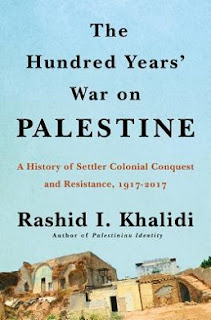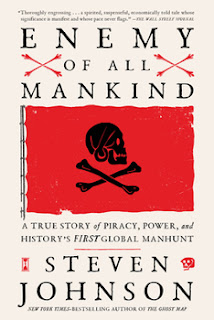The Hundred Years' War on Palestine
The Hundred Years' War on Palestine: A History of Settler Colonialism and Resistance, 1917–2017 is a 2020 book by Rashid Klaidi i, in which the author describes the Zionist claim to Palestine in the century spanning 1917–2017 as late settler colonialism and an instrument of British and then later American imperialism.
Rashid Ismail Khalidi is a Palestinian-American historian specializing in the Middle East. He has oftened appeared on TV Shows like GPS(CNN).
Theodor Herzl, father of modern political Zionism.The chapter "The First Declaration of War, 1917–1939" in "The Hundred" discusses the early 20th-century period when the foundations for the conflict in Palestine were laid. It highlights the impact of the Balfour Declaration and the subsequent British Mandate in Palestine, marking the beginning of a formal conflict against the Palestinian people. This era saw the emergence of Zionist colonization efforts and the transformation of Palestinian national sentiment into a modern form of nationalism, influenced by global trends and the aftermath of World War I. The chapter emphasizes the increasing challenges faced by the Palestinian population, including demographic changes, land ownership shifts, and economic integration into the global capitalist order, which were significantly influenced by new educational and social developments. These historical events set the stage for the later declarations of war and the continued struggle over the land and identity of Palestine.
"The Second Declaration of War, 1947–1948"
The second chapter has the United States and the Soviet Union replacing Britain in 1947 as the imperial powers, with their moves to gather international support to ensure the passage of UN partition resolution, which approved the establishment of a Jewish state on 56% of Arab majority land, thereby violating the Palestinians' right to "national self-determination"
as guaranteed in the UN Charter. It was followed by civil war in Mandatory Palestine, the Establishment of the State of Israel, the First Arab-Israeli War, and the Nakba, in which about 700,000 Palestinians fled or were expelled to neighboring Arab states.
Land that had been owned and abandoned by fleeing and ousted Palestinians was expropriated by the Israeli government to be used solely for the benefit of the Jewish people, being added to extant Jewish settlements or coming under the control of the Israel Lands Authority and Jewish National Fund.
as guaranteed in the UN Charter. It was followed by civil war in Mandatory Palestine, the Establishment of the State of Israel, the First Arab-Israeli War, and the Nakba, in which about 700,000 Palestinians fled or were expelled to neighboring Arab states.
Land that had been owned and abandoned by fleeing and ousted Palestinians was expropriated by the Israeli government to be used solely for the benefit of the Jewish people, being added to extant Jewish settlements or coming under the control of the Israel Lands Authority and Jewish National Fund.
The third chapter highlights the colonial role of the US in the Lyndon B. Johnson administration's approbation of Israel's preemptive strikes on Egypt, Jordan, and Syria in the 1967 War, as well as in its support for UNSC Resolution 242, which legitimated the lines of June 5, 1967 (prior to the 1967 War) as Israel's de facto borders—despite the fact that these borders include territory Israel conquered in the 1948 War not given to it in the partition plan—and made no mention of Palestine or the Palestinians or their rights
"The Fourth Declaration of War, 1982"
The fourth chapter also points to US compliance in Israeli aggression, with its support for the 1982 Israeli invasion of Lebanon under Menachem Begin to obliterate the Palestine Liberation Organization and Palestinian nationalism The author regards it as a joint Israeli-American operation, as the US supplied Israel with weapons and supported the expulsion of the PLO's leadership and combatants from Beirut to Tunis
This chapter is the most personal, as the author lived in Beirut for 15 years with his family It also presents damning evidence, based on documents leaked from the Israel State Archives in 2012 as well as secret appendices from the Kahan Commission that weren't published in the original 1983 report, of the Israeli government's conscious decision to send Christian militias into the Sabra and Shatila refugee camps with the clear intention of instigating the Sabra and Shatila massacre
This chapter is the most personal, as the author lived in Beirut for 15 years with his family It also presents damning evidence, based on documents leaked from the Israel State Archives in 2012 as well as secret appendices from the Kahan Commission that weren't published in the original 1983 report, of the Israeli government's conscious decision to send Christian militias into the Sabra and Shatila refugee camps with the clear intention of instigating the Sabra and Shatila massacre
"The Fifth Declaration of War, 1987–1995"
The fifth chapter addresses the brutal Israeli backlash against the First Intifada, the relentless expansion of Israeli settlements in the occupied West Bank and Gaza, and the Oslo Accords—which did not resolve any fundamental Palestinian demands, such as national sovereignty, an end to occupation and colonization, the right of return for refugees, an agreement on Jerusalem, delineated borders, and land and water rights, and which were arranged based on close political, diplomatic, and military ties between Israel and the US, and were therefore tantamount to "another internationally sanctioned American-Israeli declaration of war on the Palestinians in furtherance of the Zionist movement's century-old project."
"The Sixth Declaration of War, 2000–2014"
The sixth chapter covers four chapters of Israeli violence against Palestinians in the West Bank and Gaza: backlash against the Second Intifada and the Israeli military's three attacks on Gaza in 2008, 2012, and 2014.[3] The author notes that the massive death toll and physical destruction of buildings and infrastructure were caused by lethal weapons supplied to Israel by the US, including armed drones, Apache helicopters, F-15 and F-16 war planes, and 155mm howitzer artillery guns
The dynamics between Israel and Palestine are complex, often involving politically and emotionally charged issues. There have been instances where Israel's responses to Palestinian actions have been viewed as disproportionate by some observers and international critics. Here are examples that have been widely discussed:
- Operation Cast Lead (2008-2009): Israel launched a military operation in Gaza in December 2008, which lasted until January 2009. This operation was in response to rocket fire from Gaza into Israeli territory. The scale of the Israeli military action, which included air strikes and a ground invasion, led to significant casualties and destruction in Gaza. The United Nations reported that over 1,400 Palestinians were killed, many of whom were civilians, compared to 13 Israeli deaths (3 civilians and 10 soldiers, with 4 of the soldiers killed by friendly fire).
- Gaza War (2014): Also known as Operation Protective Edge, this conflict lasted for seven weeks in the summer of 2014. Israel's stated aim was to stop rocket fire from Gaza and destroy tunnels used by militants to enter Israel. The operation resulted in over 2,100 Palestinian deaths, with a significant number of civilians among them, and 73 Israeli deaths, primarily soldiers. The extensive bombing and ground offensive led to widespread devastation in Gaza and raised international concerns about the proportionality and necessity of the military response.
- Great March of Return (2018): During these protests, which started in March 2018 along the Gaza-Israel border, Palestinian demonstrators demanded the right to return to their ancestral lands from which they were displaced. The Israeli Defense Forces (IDF) were criticized for using live ammunition, tear gas, and sniper fire against protesters, many of whom were unarmed. According to human rights organizations, over 200 Palestinians were killed and thousands injured during these events, raising debates about the use of force against civilians.
References


Comments
Post a Comment